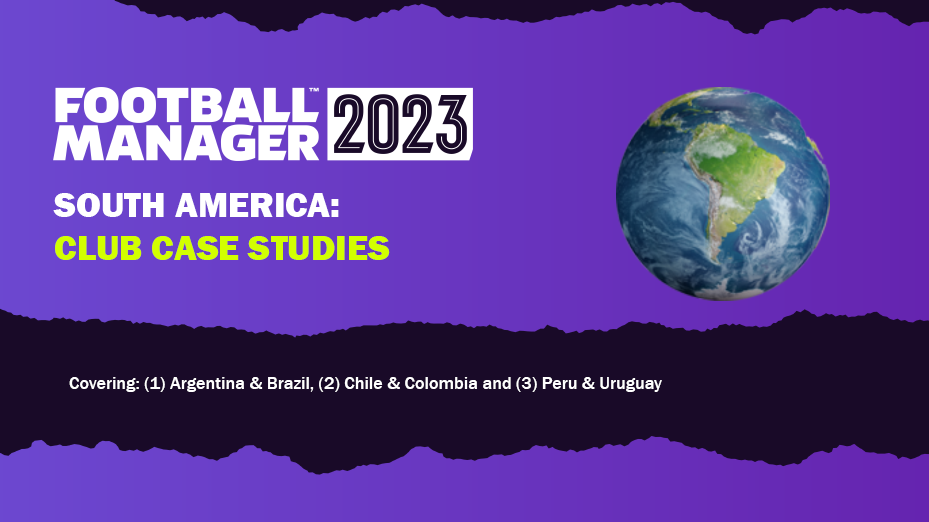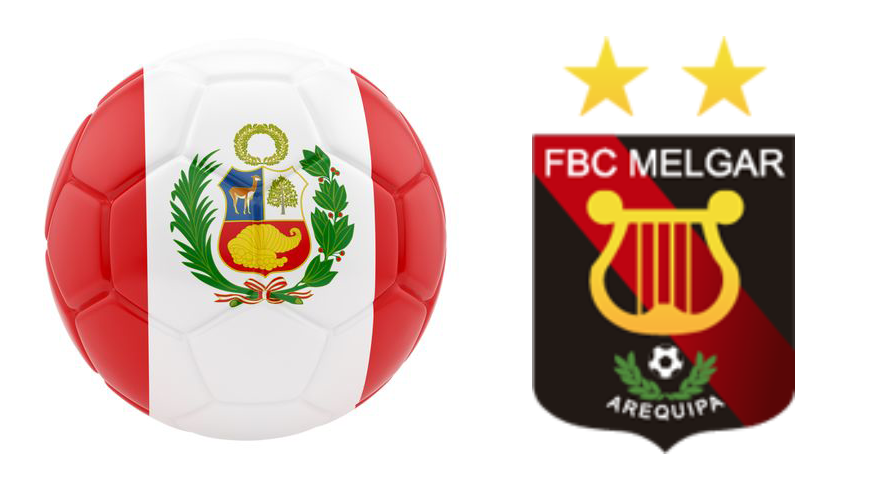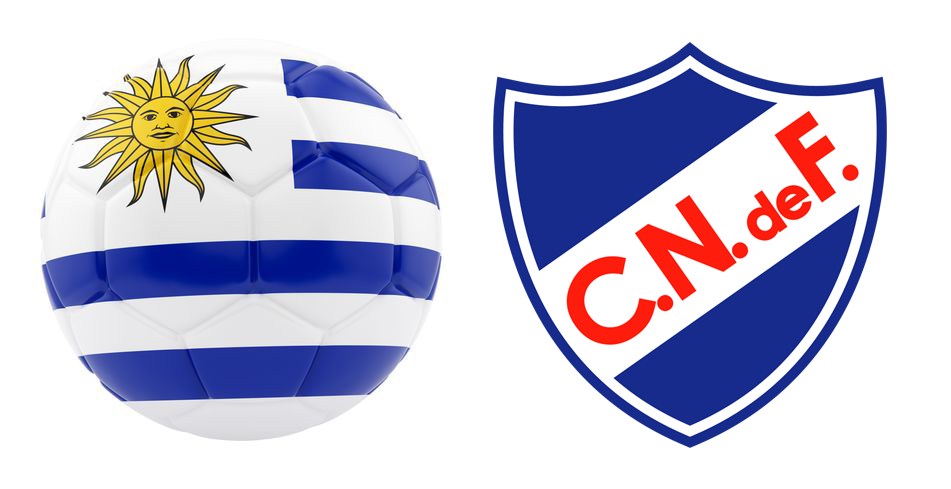Hi there,
For the last few years Fernando (@rocksendfm) has joined the blog before each new Football Manager game to introduce interesting South American clubs to manage in FM. This year, Fernando had the idea to conduct more in-depth case study pieces for one club from each nation. Due to word count, we’ll therefore be combining two nation’s case studies per blog.
This blog features case studies for Peru & Uruguay. For a brief synopsis of the league systems visit the previous league guide here.
Massive thanks again to Fernando. Go check out his own website: www.rocksendfm.com, you won’t be disappointed!
We hope you enjoy,
Tony / FM Grasshopper
Perú
Club: Football Club Melgar
Key Details:
Nickname(s): El Dominó
Founded: 1915
Ground + Capacity: Monumental Virgen de Chapi / 50,000
Owner: Private
League: Liga 1 Movistar (Peruvian First Division)
2021 finish: 5th
Background:
The city of Arequipa, sometimes called the Lion of the South, is one of huge importance for Perú. Located some 700 kms south of Lima, since Peruvian independence was proclaimed in 1821, Arequipa has acted as a counterbalance of sorts, a stabilising factor against the centralised power of the capital. It was there that Peruvian patriot Mariano Melgar was born in 1790, going on to become a poet and a revolutionaire, fighting in the Peruvian independence, before dying at the hands of the Spanish military; and it was his name that a group of Arequipa kids took when they founded Juventud Melgar in 1915, which would soon change their name to the current one.
They would start playing in the Arequipa League in 1918 and lift their first local title in 1921. In 1924 they took part in the Torneo Intercity, against sides from Lima, emerging as the winners. In 1928 they would win their last Arequipa League title in 34 years, as the team struggled during the 30s, 40s and 50s, battling two relegations and no silverware.
Victories in the 1962, 1964 and 1965 Arequipa League titles proved enough to earn them an invite to the Campeonato Descentralizado de Fútbol, the Peruvian National League, which was set up only in 1951 after years of dominance from the local leagues, mainly that of Lima. It wouldn’t be very successful, getting relegated, but just five years later they would win the 1971 Copa Perú (the first Arequipa side to manage it), and thus return to the First Division, a spot they would never lose again. In 1981, they became the first team from the Peruvian highlands to be champions of the First Division of Peru, and it was also their first qualification for the Copa Libertadores de América.
Struggling times would again come after a 2nd place finish in 1983. In 2009, the decision to leave the Estadio Mariano Melgar, with capacity for 15,000 people in favour of the 45,000 capacity Monumental Virgen de Chapi was taken, and the extra income did the trick. However, it wouldn’t be until 2012 that they would again return to their best, making a return to international competition in 2012, and then winning the title for the second time in 2015, their centenary year. Since then, they’ve remained a competitive side in the Peruvian league.
Why them in FM23?
I’ve always felt like Peruvian football is full of unexploited potential. Watching a run-of-the-mill game will make your eyes hurt, but for a country that didn’t have a national league until the 1950s, football goes way back to 1892 there, and they’ve managed to produce two (maybe three) golden generations.
Every once in a while, a team comes to fuel my theory that Peruvian foot is just a good bit of investment and some lucky results away from getting the respect it deserves, and that team right now is FBC Melgar. The Dominó made it all the way to the Copa Sudamericana semifinals in 2022, and looked fearless in doing so taking out far more fancied sides like Racing Club, Deportivo Cali and Internacional de Porto Alegre.
Right now, they have a young and talented squad and play some of the best football in the nation, sitting 5th in the Torneo Clausura and with their ticket to the Peruvian First Division Play Offs already booked as Torneo Apertura winners. With eight of the last ten league titles going to the dominant and Lima-based big three of Universitario Deportes, Alianza Lima and Sporting Cristal, isn’t it time that the Lion of the South acts as a counterbalance once again?
Key Personnel:
Being the worst South American league available on FM in terms of quality, means that managing in Peru often requires some extra creativity when it comes to talent acquisition. Regardless, Melgar have some very good players.
None as good, perhaps, as Bernardo Cuesta. The 34 year old Argentinian striker has made a stint as a bit of a South American journeyman, with stints in Bolivia, Chile, Colombia, Mexico and, of course, Perú. He’s a solid all-round striker with a deadly Finishing move, so he should be scoring plenty for you. Just don’t sleep on signing his replacement.
Next up, take a look at Kevin Quevedo. At one point touted as the next big Peruvian talent, he struggled to make it past his huge upside. What remains, however, is a very useful football. Lighting Pace, lots of Flair and a deadly Crossing foot an excellent winger make and he’s got you covered. The fact that he’s also a very skilled Corners taker is a plus.
Coming up, Kenji Cabrera. If Kevin Quevedo was the next big thing, Kenji Cabrera is his successor. Just 20 years old, he’s got Pace, Technique, Dribbling and Crossing skill. His mentals are a bit disappointing, but with time on his side he can be turned into a top producer.
Want to manage in Perú but you don’t fancy Football Club Melgar?
… great youth academy: Academia Cantolao
One of the very few instances when a great academy isn’t part of a big club, Cantolao have the necessary facilities to produce the next Jefferson Farfán or Claudio Pizarro. I’ve written about them in the previous club recommendation, so that’s recommended reading if you're interested. Other than that, Universidad de San Martín are also a good shout, but nowhere near the facilities.
… plucky underdog side: ADT
If you ever feel like learning about a bonkers league system, take a look at the Copa Perú, the third division of Peruvian football which grants promotion to, you guessed it, the First Division of Peruvian football. For now, at least, with 2022 being the last edition where this wonderful quirk will be ended. ADT, therefore, is one of the last privileged sides to have waved the finger at the second tier and taken the quick way. We’ll miss you, Copa Perú.
… fallen giant: Universitario de Deportes
With no lower Peruvian tiers in the FM23 vanilla DB, I have to settle for Universitario Deportes. At one point the biggest and most important club in Perú, they are now hanging by a thread to the most league titles record, with 26 wins to Alianza Lima’s 24 and, most importantly, Sporting Cristal’s 20 titles and counting. Their new found habit of winning it once each decade surely isn’t helping, with their last title in 2013.
… big side to win the Copa Libertadores: Sporting Cristal
At one point a third fiddle to Clásico de Lima rivals Universitario and Alianza Lima, now Sporting Cristal are the best side in Perú. Title wins in 2012, 2014, 2016, 2018 and 2020 mean they are closing in fast to Universitario’s record, and their Copa Libertadores final appearance in 1997 ruined made them the second ever Peruvian side to feature. Don’t get me wrong, they are a LONG way away from competing, with 2004 being the last time they made it out of the Group Stage, but they are a lot closer than anyone else in Perú.
Uruguay
Club: Club Nacional de Football
Key Details:
Nickname(s): Tricolores
Founded: 1899
Ground + Capacity: Gran Parque Central / 31,395
Owner: Club
League: Campeonato Uruguayo (Uruguayan First Division)
2021 finish: 3rd
Background:
At the start of the 20th century, football in the Río de la Plata Basin was still pretty much a British-influence thing. Clubs had started popping up since the late 1880s, but they were all part of British owned ventures, such as the Central Uruguay Railway Cricket Club (CURCC, later Peñarol) which was a club for the company workers, or Alumni Athletic Club in Argentina, where the former students of the Buenos Aires English High School played. However, that would soon change, and one of the first signs of that change was the birth of the Club Nacional de Football, better known as Nacional.
On May 14, 1899, a group of teenagers, members of the Uruguay Athletic Club and the Montevideo Football Club decided to merge their sides. Their idea was to create the first ever “criollo” football club, the first ever to embody not British tradition, but Uruguayan sentiment. This choice was implicit in the name they chose, but also in the colours: white, red and blue were the colours of the flag flown by José Gervasio Artigas, the founding father and biggest national hero of Uruguay.
Nacional would find success quickly. In 1901 they were admitted into the The Uruguay Association Football League, and as soon as 1902 they became undefeated champions, under the guidance of the brothers Amílcar, Bolívar y Carlos Céspedes. Quickly, a fierce rivalry with the CURCC was born, with both sides often fighting for the Uruguayan title.
On September 13, 1903, the National Teams of Uruguay and Argentina were set to face each other. The Uruguayan Federation named a match made mostly of Nacional players, and that annoyed CURCC, who refused to lend their players. When Montevideo Wanderers Fútbol Club also refused the players who were called as replacements, Nacional assumed the complete representation of the Uruguayan team. The match brought the historic 2:3 victory of the Uruguayans, their first ever. A similar thing would happen in 1924, when an almost entirely Nacional team was sent to the Olympic Games to represent Uruguay in football and won Gold.
It was around this time that Nacional gave South American football one of its most characteristic traits, the hinchas. Prudencio Miguel Reyes was the club’s kit man, and was also in charge of inflating (in Rio de la Plata Spanish, “hinchar”) the balls used. When the games started, Reyes would stay in the sidelines, jumping and singing to cheer on the team, and he became known as the “hincha” of Nacional, which would become the word used across the continent to describe the fans.
In 1939, another landmark: the Quinquenio de Nacional. The Tricolores went and won the title five years in a row, and won 32 matches straight between October 1940 and July 1942. While they would never repeat that level of dominance, they would continue to be constant challengers and regular winners of the Campeonato Uruguayo, where Nacional and CURCC/Peñarol have won all but 19 of the 119 titles contested.
Internationally, during the 1960s they would have to watch rivals Peñarol rule the Copa Libertadores, but success finally arrived in 1971, with their first of three titles, and they would also pick up the Intercontinental Cup that same year, beating Panathinaikos after European Cup winners Ajax refused the trip. They would repeat the double in 1980 and 1988.
Apart from that dominance in the Uruguayan championship, Nacional also highlighted as one of the best youth developers in the country, with the likes of Diego Lugano, Sebastián Coates, Juan Ángel Albín, Gonzalo “Chory “ Castro, Sebastián Viera, Nicolás Lodeiro and Luis Suárez coming through in the last few years
Why them in FM23?
Sometimes, people criticise Football Manager for being a bit unrealistic due to crazy signings happening or improvable wins taking place. Most of the time, it's an unreasonable complaint. For starters, if the guys at SI ever produce a software capable of perfectly replicating real life, they’d be selling it to professional clubs or stats companies, not football obsessed geeks. For everything else, there are also times when real life is too unrealistic even for FM. The reason you should manage Club Nacional de Football in FM23 has a full name: Luis Alberto Suárez Díaz, aka, Luis Suárez.
I’ve managed Nacional in every Football Manager since 2019. Each and every time, I’ve tried to sign Luis Suárez, and each and every time I’ve failed. I know guys from Uruguay who have played Nacional more than once per cycle across many editions of the game. Each and every time, they’ve tried to sign Luis Suárez, and each and every time they’ve failed. In FM, it’s impossible; yet, in real life, Nacional have managed to do it.
It’s very hard to take proper dimension to the importance and the meaning of Suárez’s signing for Nacional and Uruguayan football, although Maradona’s arrival to Napoli rings a bell. When Suárez admitted on TV he was open to the move after his River Plate transfer failed, the #SuarezANacional hashtag became a world-wide trending topic. When the contract was agreed, thousands of people went to receive El Pistolero at the airport, and the van taking him to the stadium had to advance at walking pace because people surrounded it, trying to catch a glimpse of the player. Nacional sold more Luis Suárez shirts the day he was presented at the Gran Parque Central than they had sold shirts (any shirts) up to that point. It was quite simply unbelievable.
In real life, sadly, the dream was short. Luis Suárez helped Nacional to another title, but could not inspire a run in the Copa Sudamericana, and it is already known that he will be leaving the club at the end of the season, potentially moving to the MLS. So, why should you manage Nacional in FM23? Because you won’t get another chance of having Luis Suárez at his favourite club. Who knows, perhaps you can even convince him to extend his stay… FM is known to be unrealistic at times.
Key Personnel:
Well, who do you think it’s going to be? Luis Suárez is going to be the focus of your early game if you manage Nacional. El Pistolero is showing signs of his 35 years of age: his physicals are down, his legs don’t have the same spring and he will have to leave the game around the 70th minute mark, but, for everything else, he’s head and shoulders above the rest of the league.
Clinical Finishing, deadly Passing, great First Touch and Technique and mentals unlike anyone else, getting the best out of Suárez will largely dictate how far you’ll get in the first season. His contract expires at the end of the year, so negotiations will be key, but should everything else fail… you’ll have fun watching him outclass every centreback in the league.
Next up, Sergio Rochet. One of the safest pairs of hands in South America, Rochet is marked for a move away from Nacional very soon. Having inherited the spot between the sticks for La Celeste from Fernando Muslera, he’s established himself as the best goalkeeper in the country and with good reason. Solid overall, his fantastic Reflexes and stupendous reach make him a top shot stopper, and one you’d do well to keep around.
Last but not least, it’s Leo Coelho. The Brazilian is on loan from Mexican side Atlético San Luis, so he’s another you could be enjoying for a short time, but for the first season at least, he’s going to be the base of your defence. Impressive in the air, but with a good reading of the game and good with the ball at his feet, he’s the complete pack.
Honourable mention to Augusto Scarone and Renzo Sánchez in your under 19s, who could quickly give the fans reason to forget about Suárez departure.
Want to manage in Uruguay but you don’t fancy Club Nacional de Football?
It could be argued that Nacional is a short term save in FM23. Even if you keep Luis Suárez past his original contract, he’s set to retire sooner rather than later, and when that happens it’s just another big club save, perhaps even more dominant than managing a big side in Europe. So if you’re tempted by Uruguay but want something more long term, here’s who to consider if you’re looking for a…
… great youth academy: Danubio Fútbol Club
For a more “typical” pick, go Defensor Sporting Club, but don’t overlook Danubio. Álvaro Recoba, Ernesto Chevantón, Diego Forlán, Walter Gargano, José María Gimenez and Edinson Cavani are some of the players that came through their academy, so the heritage is there, and now that they’re back in the First Division you can try to carry their “University of Football” spirit going.
… plucky underdog side: Plaza Colonia
The Cinderella story of the 2021 Campeonato Uruguayo, they won the 2021 Torneo Apertura to set up a title decider semifinal against eventual winners Peñarol, who they took all the way to a penalty shoot out. Still, that was enough to get a ticket to the Copa Libertadores qualifying rounds, which you can enjoy on FM23.
… fallen giant: Montevideo Wanderers Fútbol Club
In all honesty, only two giants exist in Uruguayan football: Nacional and Peñarol. That being said, Montevideo Wanderers are three time champions who haven’t lifted any silverware in almost 100 years. Alternatively, Albion Football Club could be argued to be the oldest club still active in Uruguay.
… up and coming side: Montevideo City Torque
One I mentioned in the guide last year, few clubs have so many things going for them to overcome the duopoly of Nacional and Peñarol as MCT. Backed by the City group, they’ve been poaching talent from everywhere in the country. They’re yet to turn that into silverware, but that’s the challenge, isn’t it? Alternatively, this year’s runners up Liverpool FC are arguably the best run club in Uruguay.



